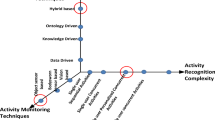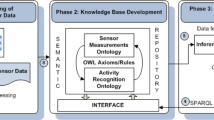Abstract
The emerging availability of already deployed sensors that can be utilized for activity and context recognition raised a new paradigm. This paradigm called opportunistic sensing utilizes the available sensing infrastructure for activity and context recognition. This work focuses on utilizing this dynamically varying sensing infrastructure to recognize high-level composed activities in an adaptable way. The proposed methods use activity relations modeled in an ontology. This domain knowledge is used to dynamically configure hidden Markov models (HMM) and evidential networks. These models are popular in activity and context recognition systems due to their high recognition accuracy. A goal oriented approach is proposed to dynamically create and instantiate these models. The goal encapsulates the recognition purpose of the activity and context recognition system and is expressed in an abstracted and semantic manner. This flexible approach utilizes the opportunistic sensing principles. It directs the dynamic configuration of the activity and context recognition system during runtime. The configured recognition models are based on the recognition purpose of the system, and the configured sensing ensemble depends on the available sensing infrastructure. This enables the dynamic configuration and adaption of the activity and context recognition system during runtime to detect composed and time sequenced activities using HMMs or evidential networks in an opportunistic way.







Similar content being viewed by others
References
Aarno D, Kragic D (2006) Layered hmm for motion intention recognition. In: Proceedings of the IEEE/RSJ international conference on intelligent robots and systems, Iros’06, pp 5130–5135
Frenken T, Brell M, Gövercin M, Wegel S, Hein A (2012) atug: technical apparatus for gait and balance analysis within component-based timed up and go using mutual ambient sensors. J Ambient Intell Humaniz Comput, pp 1–20
Han CW, Kang SJ, Kim NS (2010) Implementation of hmm-based human activity recognition using single triaxial accelerometer. IEICE Trans 93(A7):1379–1383
Han K, Veloso M (2000) Automated robot behavior recognition applied to robotic soccer. In: Proceedings of the 9th international symposium on robotics research, Springer, Berlin, pp 199–204
He J, Hu S, Tan J (2008) Layered hidden markov models for real-time daily activity monitoring using body sensor networks. In: Proceedings of the 5th international summer school and symposium on medical devices and biosensors, 2008, pp 326–329
Hong X, Nugent C, Mulvenna M, McClean S, Scotney B, Devlin S (2009) Evidential fusion of sensor data for activity recognition in smart homes. Pervasive Mobile Comput 5(3):236–252
Kasteren T van Noulas A, Englebienne G, Kröse B (2008) Accurate activity recognition in a home setting. In: Proceedings of the 10th international conference on ubiquitous computing, ACM, New York, pp 1–9
Kurz M, Hölzl G, Ferscha A, Calatroni A, Roggen D Troester G (2011a) Real-time transfer and evaluation of activity recognition capabilities in an opportunistic system. In: Proceedings of the 3rd international conference on adaptive and self-adaptive systems and applications (adaptive2011), 25–30 Sept 2011, Rome, Italy, pp 73–78
Kurz M, Hölzl G, Ferscha A, Calatroni A, Roggen D, Tröster G (2011b) The opportunity framework and data processing ecosystem for opportunistic activity and context recognition. Int J Sens Wirel Commun Control (Special Issue on Autonomic and Opportunistic Communications, 1
Kurz M, Hölzl G, Ferscha A, Sagha H, Millán R, Del J, Chavarriaga R (2011c) Dynamic quantification of activity recognition capabilities in opportunistic systems. In: Proceedings of the 4th conference on context awareness for proactive systems: Caps2011, 15–16 May 2011, Budapest, Hungary
Ogris G, Stiefmeier T, Lukowicz P, Troster G (2008) Using a complex multi-modal on-body sensor system for activity spotting. In: Proceedings of the 2008 12th IEEE international symposium on wearable computers, IEEE Computer Society, Washington, DC, USA, pp 55–62
Rabiner L (1989) A tutorial on hidden Markov models and selected applications in speech recognition. Proc IEEE 77:257–286
Roggen D, Calatroni A, Rossi M, Holleczek T, Förster K, Tröster G (2010) Collecting complex activity data sets in highly rich networked sensor environments. In: Proceedings of the 7th international conference on networked sensing systems (INSS) at IEEE Computer Society Press, Kassel, Germany
Roggen D, Förster K, Calatroni A, Tröster G (2013) The adarc pattern analysis architecture for adaptive human activity recognition systems. J Ambient Intell Humanized Comput 4(2):169–1s86
Roggen D, Troester G, Lukowicz P, Ferscha A, Millán R, Del J, Chavarriaga R (2013) Opportunistic human activity and context recognition. Computer, 46(2):36–45
Rybski PE, Veloso MM (2004) Using sparse visual data to model human activities in meetings. Modelling other agents from observations workshop (moo 2004)
Shafer G (1976) A mathematical theory of evidence. Princeton university press, Princeton
Sukthankar G, Sycara K (2006) Robust recognition of physical team behaviors using spatio-temporal models. In: Proceedings of the 5th international joint conference on autonomous agents and multi-agent systems (aamas) (pp 638–645)
Sung J, Ponce C, Selman B, Saxena A (2011) Human activity detection from RGBD images. CoRRabs/1107.0169
Sung J, Ponce C, Selman B, Saxena A (2012) Unstructured human activity detection from rgbd images. Icra, pp 842–849
Wu Y-C, Chen H-S, Tsai W-J, Lee S-Y, Yu J-Y (2008) Human action recognition based on layered-hmm. In: Proceedings of the 2008 IEEE international conference on multimedia and expo, pp 1453–1456
Zhang S, McCullagh P, Nugent C, Zheng H, Black N (2013) An ontological framework for activity monitoring and reminder reasoning in an assisted environment. J Ambient Intell Humanized Comput 4(2):157–168
Acknowledgments
The project OPPORTUNITY acknowledges the financial support of the Future and Emerging Technologies (FET) programme within the Seventh Framework Programme for Research of the European Commission, under FET-Open Grant Number: 225938. The project PowerIT acknowledges the financial support of the Austrian Research Program of the FFG under Grant Number: 818898.
Author information
Authors and Affiliations
Corresponding author
Rights and permissions
About this article
Cite this article
Hoelzl, G., Kurz, M. & Ferscha, A. Goal oriented recognition of composed activities for reliable and adaptable intelligence systems. J Ambient Intell Human Comput 5, 357–367 (2014). https://doi.org/10.1007/s12652-013-0198-3
Received:
Accepted:
Published:
Issue Date:
DOI: https://doi.org/10.1007/s12652-013-0198-3




